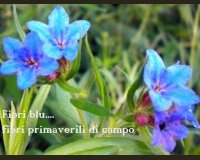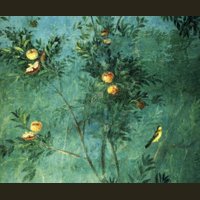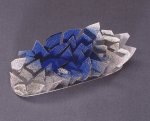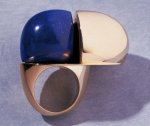accueil site > 45. Archives > 20. International > 02. GRUNDTVIG > 02. The languages of the blue > The stages of the blue > 14. 16 february 2011.Ravenna, IT The colour Blue: integral part of (...)
14. 16 february 2011.Ravenna, IT The colour Blue: integral part of goldsmith’s art Friday 18 February 2011
The chromaticism was always a leading element in the creation and in a jewel project since Antiquity until our days. Whether it’s a jewel for the aristocracy, for the richest middle- class , whether it’s a popular work of not enough price, the jewel always exhorted the man who created it, the goldsmith who realized it, to colour it. In Fashion current World, which always saw the jewel as an accessory of clothing , the ornament color has to be in sintony with the style and the fabric of the cloth of which the stylist thought for the woman.
For the artists who faced the jewel adventure f in Italy, the color was always considered as an useful element for research and experimentation. This color has to go into the languages’ canon , articulated and complex , appropriate for every painter or sculptor. Certainly the blue is a primary color which is particularly intense, which has a dominant strength and a presence, difficult to control and to use in the goldsmith’s art.
Some significant examples of artists’ jewels are the ones of Meret Oppenheim in a necklace in 1977 entitled " Head of the Poet " yellow gold and enamel with a predominance of the blue underlining the face and highlithing the big blue -black eyes.
From a very beautiful project, from Sonia Delaunay’s drawing in 1923 for an important necklace " Rythme sans fin ", which was realized in 1978 by" Edizioni Gem Montebello di Milano", we created a pendant- brooch, of geometrical shape, which plays on blue tints given by the "miniaturé" enamel.
Another remarkable artist, Giuseppe Uncini an Italian sculptor , recently disappeared, ventured into the jewelry by trying to remain connected to the tradition, who always elected as representative of the blue, the sapphire, the precious stone which is part of the most expensive triad of minerals (diamond, emerald and ruby. In a brooch of 1964 and in a necklace of 1968, sapphires with facets are inlayed in a dense, threadlike mesh, golden built , typical of the iron and ciment sculptures with large-dimension realized by the artist .
Numerous are the experiences goldsmith which Italian architects and designers made on the chromatic plan, but few on the blue.
The European project which our Fine Arts Academy began by underlining particularly the presence of the blue in the colour stones, gave me a motive to show how much in my work as a jeweller, which is in relation with the sculpture, an extraordinary hard stone as the lapis lazuli is a part of the imagination and the creation of the jewelry .
The main content of lapis lazuli is lazurite. Lapis lazuli also containts:sodalite, calcite and pyrite. It has a density of 2,70 - 2,90 and a hardness, a resistance according to the scale of Moths 5 5,5. It is very surprising to observe golden color tracks in its coloration, resulting from the presence of pyrite. I always used lapis lazuli as the integral part of the jewel, either as a chromatic mass in dialogue with the gold, sometimes with the steel or the white gold, or as a plastic element. So the lapis lazuli is in the jewel as the marble in a big dimension sculpture. There is only a difference in the scale, but the creative idea, the system of the composition and the structure are the same.
Other experiences in blue in my golden language were realized thanks to the enamel with deep flame, reaching 850 degree and creating very dense surfaces of small rather intense and darker grains. The result is a midnight blue.
Recently the blue appears in jewels composed of precious stones as gold and silver, but also with poorer stones as copper, brass, through the oil painting. The idea is exactly to unite the painting and the sculpture in the goldsmith’sart.
The oil painting jewell, with the color blue to create incredible chromatic contrasts, to give to surfaces a sensation of material and an alive impression is one of last researches and studies which I confront.
An extraordinary example of a lapis lazuli goldsmith’s work , used as a personal object, is the " Vase en Lapis lazuli ", composed with this blue mineral, modelled and created by Bernardo Buontalenti in 1583 in Florence for the Medici Court (Collection of the Argenti Museumdu Palazzo Pitti Florence). This shows the volatility of this incredible mineral, which in the ideation of the man through centuries and in the time was always used for various applications and varied manners.
By Alberto Zorzi


















 Printable version
Printable version


